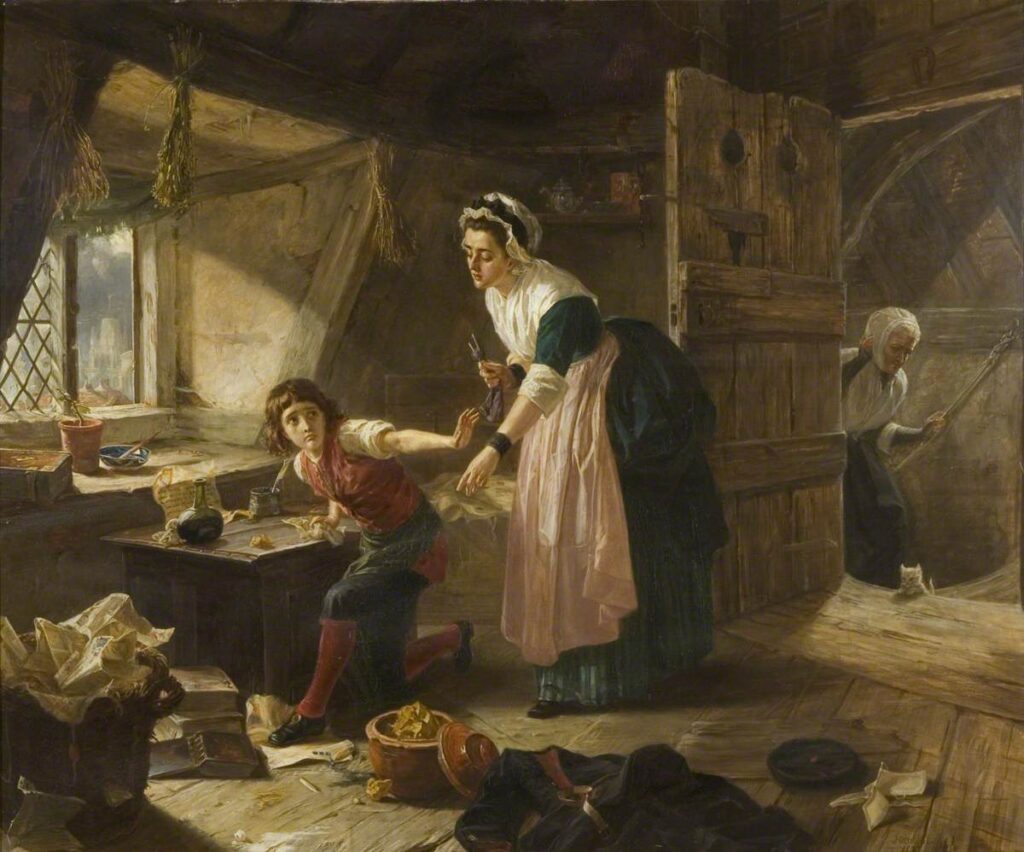Commemorating 100 years since the death of Henrietta Ward, Victorian history painter

A century ago yesterday, on the 12 July 1924, one of the few highly successful women painters of Britain died: Henrietta Mary Ada Ward. Although almost forgotten today, and barred from joining the Royal Academy because she was a woman, she exhibited regularly in the Academy’s exhibitions, and benefited from royal patronage.
She came from an artistic family: her grandfather, James Ward (1769-1859) was a successful animal artist to the royal family. She married another painter with the same surname at the age of only sixteen, and despite having eight children she pursued a successful career. After training at the Bloomsbury Art School, she was well-established by 1852 when the family moved to Slough, for its proximity to the royal court at Windsor. She met Queen Victoria and Prince Albert on many occasions, and was often called to Windsor to paint for them, and to teach the royal children to paint. She was active in artistic and literary circles, and a friend of Wilkie Collins, Charles Dickens and George Cruikshank.
Henrietta Ward (1832–1924), Princess Beatrice, later Princess Henry of Battenberg (1857-1944) when a Child (1857), oil on canvas, 13.9 x 17.4 cm, Royal Collection of the United Kingdom, Windsor, England. Wikimedia Commons.
In 1857, Ward was invited to paint Princess Beatrice, later Princess Henry of Battenberg (1857-1944) when a Child. Beatrice was born at Buckingham Palace, London, the fifth daughter of Victoria and Albert. She married Prince Henry of Battenberg in 1885.
In 1859 the Wards moved back into central London, to live in a ‘villa’ in Kensington.
Henrietta Ward (1832–1924), The Princes in the Tower (1861), oil on canvas, 61 x 54.5 cm, Touchstones Rochdale, Rochdale, England. Wikimedia Commons.
In 1861 she painted her account of The Princes in the Tower. These are the deposed King Edward V of England and his younger brother Prince Richard of Shrewsbury, Duke of York, who were twelve and nine years old respectively when they were confined to the Tower of London in 1483, by their uncle Richard, Duke of Gloucester. It has been widely assumed that he had them murdered, but their bodies have never been identified.
Henrietta Ward (1832–1924), Palissy the Potter (1866), oil on canvas, 108 x 133.4 cm, Leicester Museum & Art Gallery, Leicester, England. Wikimedia Commons.
Her 1866 painting of Palissy the Potter was exhibited to acclaim at the Royal Academy. Bernard Palissy (c 1510-1589) was a French Huguenot engineer who struggled to imitate Chinese porcelain and maiolica over a period of sixteen years. This shows an episode when success seemed so close, but the flints forming his furnace fused and destroyed all his pottery.
Henrietta Ward (1832–1924), The Queen’s Lodge, Windsor, in 1786 (c 1872), oil on canvas, 118 x 133.3 cm, Walker Art Gallery, Liverpool, England. Wikimedia Commons.
The Queen’s Lodge, Windsor, in 1786 (c 1872) shows a royal residence favoured by Queen Anne, wife of King George III, who had what had been Cumberland Lodge in Windsor renovated for her use. She loved this country house on the south side of Windsor Castle, and the nearby Burford House. The royal family moved there in the summer of 1778, and lived there for much of the next twenty-five years. Following the king’s death, his son King George IV had it demolished in 1823.
Henrietta Ward (1832–1924), Chatterton (or, the Secret Message) (c 1873), oil on canvas, 90.1 x 111.1 cm, Bristol Museum & Art Gallery, Bristol, England. Wikimedia Commons.
Chatterton (or, the Secret Message) (1873) features Ward’s son Wriothesley in the title role. When she was completing this painting in her studio, she was visited by the young John Everett Millais, who added the kitten’s tail (on the doorstep at the right). It was then exhibited at the Royal Academy that year.
Thomas Chatterton (1752-1770) was a studious youth who was able to pass himself off as a fictitious fifteenth-century poet, but poisoned himself in despair at the age of only seventeen. He is shown writing in the attic of his family’s house near Bristol, stopping his mother from inspecting one of his forged parchments.
In 1875 Ward was proposed as a member of the Royal Academy, but as its membership at the time was exclusively male, she was refused.
After her husband’s death in January 1879 she established a teaching studio for girls in Windsor, moving into London three years later. She eventually moved to Chelsea, where she painted landscapes until her death there in 1924, at the age of 92.
